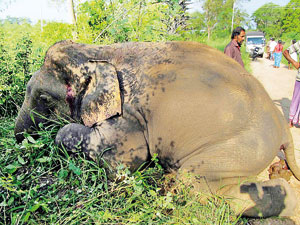News
Co-habitation between man and elephant the only answer to solve HEC

Affected villagers demand redress to the issue
Co-existence is the one and only answer to the human-elephant conflict (HEC) and weaving this into the development plans of areas in the grip of HEC is the need of the hour.
This is the firm belief of the Chairman of the Centre for Conservation and Research (CCR), Dr. Prithiviraj Fernando who has been conducting research on elephants for over 25 years.
The mitigation of the HEC is not the duty of the Department of Wildlife Conservation (DWC) alone, he tells the Sunday Times when we catch up with him in Galgamuwa.
Citing Wayamaba (North Western Province) as a ‘classic’ example, Dr. Fernando points out that there are a couple of million people, houses and home gardens, about 200,000 acres of paddy and around 2,000 elephants in an area of about 750,000 hectares. Everybody expects about 50 DWC officers in Wayamba to prevent the HEC. These officers are stretched and strained to their limits trying to “conserve people and their property” rather than doing their job of safeguarding and conserving wildlife including elephants.
“The HEC has to be handled by the appropriate stakeholders, with the people who suffer due to the HEC taking the primary measures to address the problem. A major role in mitigating the HEC has to be played by officials and agencies whose responsibility is the ‘people’s welfare’. They would include administrative officials such as the District Secretary, the Divisional Secretaries and their teams including the Grama Niladharis; the development agencies such as Mahaweli, Agriculture and Irrigation Departments; and also the Disaster Management authorities, as the HEC is a man-made disaster. Conservation agencies can and should only play a secondary role,” he says.
Dr. Fernando laments that unplanned development, which is encroaching more and more into the homes of wild elephants, is creating a crisis in the area. There are large-scale encroachments by influential Colombo people and companies who are acquiring land in the area and cultivating large extents. This takes away the limited elephant habitat and obstructs elephant movements. Consequently, there is confrontation and conflict. The moment someone gets killed there are protests against the DWC and a clamour for the elephants to be taken elsewhere.
But that is not the answer, the Sunday Timeslearns. These wild elephants have been in the area from time immemorial. It is almost impossible to remove them by force from their ‘traditional homes’ and incarcerate them in Protected Areas elsewhere. If that is done they do not survive. Like in other parts of the country, countless elephant drives have been carried out in Ehetuwewa and Galgamuwa areas annually. The DWC is forced to continue this activity although such drives are futile and, in fact, increase rather than mitigate the HEC.

Elephant falls victim to the wrath of villagers
The CCR had facilitated the DWC to track a number of elephants using radio collars which clearly showed that the elephants refused to leave and/or kept returning to their ‘traditional homelands’ where they had lived all their lives, being born, eating, drinking, mating, producing babies, growing up and dying.
Thereafter, some of these free-roaming elephants have been fenced in, limiting their range to the Inginimitiya reservoir and the teak plantation in Galgamuwa and preventing them from utilizing half their home range on the Ehetuwewa side. As a result the elephants have no recourse, but to break the fences or starve to death. In such situations, it is the problem-causing male elephants that break the fences and continue their depredations, but the innocent female herds and young which suffer.
Making matters worse, the Sunday Times understands, is that in an elephant drive, there is severe confrontation. Elephants are confronted inside the forest where they are hiding during the day, they are hollered at, thousands of huge fire-crackers are lit and thrown at them and they are sprayed with shotgun pellets.
“The elephants face this intense conflict repeatedly and who is the perpetrator of their pain, agony and trauma? Humans! Then, when they do not leave, or return to their homeland, as they are wont to do and as scientific research has established beyond doubt, what would be the consequence? They go into the fields and when a farmer tries to chase them, the elephants simply see red. What else can be expected of wild animals,” asks Dr. Fernando.
This is why co-habitation between human and elephant must and should be woven into the development plan and measures taken to ensure this, he adds.
(Please see PLUS Cover)

